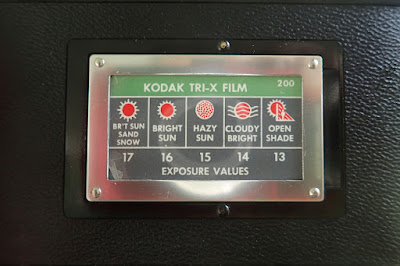The Eastman Kodak Company made 35mm cameras in Rochester, New York, from 1938 (the Kodak 35) until 1969 (the Kodak Automatic 35R4 and the Kodak Motormatic 35R4). My Signet 30 was made from 1957 to 1959. The original list price was $55.00 (about $500 in today's depreciated dollars).
Kodak Signet 30
Top
Bottom
Left
Right
The View through the Viewfinder
The Exposure Card for Kodak Tri-X Film
Interior
The camera body is made from plastic with some metal parts and trim. The front of the camera has the window for the viewfinder, the shutter release, the rewind clutch and the exposure counter. The back of the camera has the eyepiece for the viewfinder and a holder for a Kodak exposure guide card. The top of the camera has the rewind knob, an accessory shoe and hangers for the neck strap. The bottom of the camera has the film advance lever and the tripod socket. The flash connection is on the left side. The camera back is hinged on the left and the latch is on the right. The controls are arranged around the lens barrel. Starting at the front there is the distance scale, the depth of field scale, the shutter speed scale and the aperture scale on the top of the lens barrel. The exposure value scale is on the bottom.
The lens is an f/2.8-f/22, 44mm, coated (Kodak called it "Lumenized") Ektanar lens with three elements in three groups. The lens focuses by rotating the front cell. The Signet 30 is a scale focuser. You measure or guess the distance to your subject and then set the distance on the lens. It can focus as close as 2.5 feet. The distance scale is marked in feet and has diamond shapes for zone focusing: scenes, groups and close-ups. You set the aperture by pushing in and turning the aperture ring. The lens takes Series V drop-in filters for color correction or black and white contrast effects.
The lens is in a Kodak Synchro 250 Shutter. The shutter speeds are 1/4, 1/8, 1/15, 1/30, 1/60, 1/125, 1/250 second and "B". The shutter has a socket for a cable release on the side. The camera needs to be loaded with film for the film advance lever to cock the shutter. The shutter speed is set by turning the shutter speed ring to the desired speed.
This camera uses the exposure value system. A film exposure value card slips into a holder on the back of the camera, and provides exposure value numbers for different daylight conditions with the Kodak films that were sold at the time the camera was made. Of the eight films, only Tri-X is still sold. You would read an exposure value from the card for your film based on the lighting. For example, on an ordinary sunny day the exposure value is 16 with Tri-X film. You would set EV 16 on the exposure value scale by pushing in the aperture ring and turning it. The aperture and shutter speed rings are normally connected. A limited range of exposure values are available for a given shutter speed. A set of lines on the exposure value scale shows the range of exposure values available with a given shutter speed. You can set the exposure value in half-steps. If you ran off the end of the scale you would change the shutter speed to shift the EV scale as needed.
You also could select a shutter speed and an f-stop in the traditional way. You should set the shutter speed first and then set the aperture. If you set the aperture first, then changed the shutter speed, the aperture setting would change to follow the shutter speed in order to maintain a constant exposure value.
Exposure values are equal to the base 2 logarithm of the denominator of the shutter speed plus 2 times the base 2 logarithm of the f-stop. 1/30 second at f/16 gives an exposure value of 13. 1/60 second at f/11, 1/125 second at f/8 and 1/250 second at f/5.6 also give an exposure value of 13. All pairs of settings will give a negative the same exposure. One step on the exposure value scale changes the exposure on the negative by a factor of 2. EV 13 gives twice the exposure of EV 14 and half the exposure of EV 12.
The camera has a "Kodalite" pin-and-screw fitting for a flasholder. The shutter will synchronize with flash bulbs at 1/30 second or with electronic flash at any speed, although as far as I'm aware Kodak did not sell an electronic flash to fit this camera.
The viewfinder is bright and clear. The only information displayed in the viewfinder is a reminder to wind the film, which appears after you press the shutter release and disappears after you wind the film.
Loading the camera involves opening the back, putting the fresh film cassette into the film chamber on the left side of the camera, then pulling the film over the sprocket wheels and hooking the film leading onto the little tooth on the take-up drum. You then close the back and advance the film until it stops. Advancing the film cocks the shutter. There isn't any way to make a double exposure. When the film is used up you push and hold the rewind lever and turn the rewind knob until the film is back inside the cassette. You can then open the back and remove the film for processing.
The Harpeth River Flowing over the Newsom's Mill Dam











